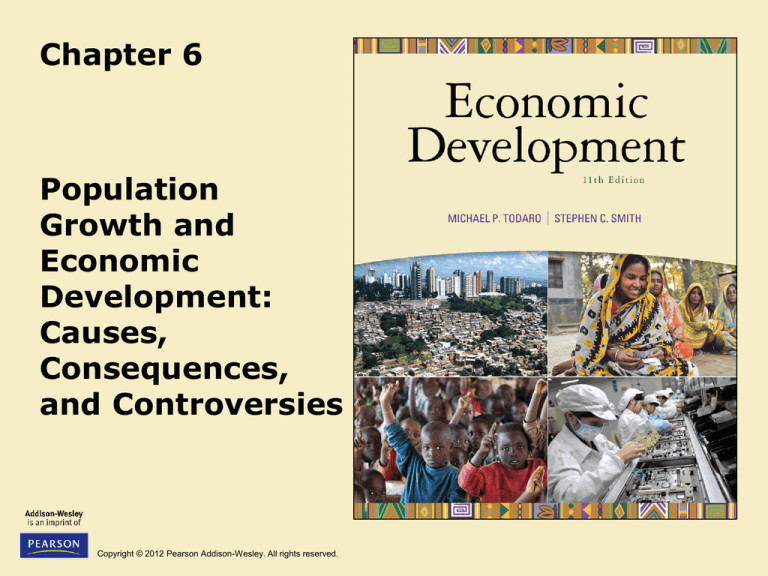
Chapter 6
Population
Growth and
Economic
Development:
Causes,
Consequences,
and Controversies
Copyright © 2012 Pearson Addison-Wesley. All rights reserved.
6.1 The Basic Issue: Population Growth
and Quality of Life
• Six major issues:
– Will developing countries be able to improve
levels of living given anticipated population
growth?
– How will developing countries deal with the
vast increases in their labor forces?
– How will higher population growth rates affect
poverty?
Copyright © 2012 Pearson Addison-Wesley. All rights reserved.
6-2
6.1 The Basic Issue: Population Growth
and Quality of Life
• Six major issues (cont’d):
– Will developing countries be able to extend the
coverage and improve the quality of health
care and education in the face of rapid
population growth?
– Is there a relationship between poverty and
family size?
– How does affluence in the developed world
affect the ability of developing countries to
provide for their people?
Copyright © 2012 Pearson Addison-Wesley. All rights reserved.
6-3
6.2 Population Growth: Past, Present, and
Future
• World population growth through history
Copyright © 2012 Pearson Addison-Wesley. All rights reserved.
6-4
Table 6.1 Estimated World Population Growth
Copyright © 2012 Pearson Addison-Wesley. All rights reserved.
6-5
Figure 6.1 World Population Growth, 17502050
Copyright © 2012 Pearson Addison-Wesley. All rights reserved.
6-6
Figure 6.2 World Population Distribution by Region,
2010 and 2050
Copyright © 2012 Pearson Addison-Wesley. All rights reserved.
6-7
6.2 Population Growth: Past, Present, and
Future
• Structure of the world’s population
–
–
–
–
–
Geographic region
Fertility and Mortality Trends
Rate of population increase
Birth rates, death rates , Total fertility rates
Age Structure and dependency burdens
Copyright © 2012 Pearson Addison-Wesley. All rights reserved.
6-8
Figure 6.3 The Population Map: World Map with
Country Sizes Proportional to Population, 2005
Copyright © 2012 Pearson Addison-Wesley. All rights reserved.
6-9
Table 6.3 Fertility Rate for Selected Countries, 1970
and 2009
Copyright © 2012 Pearson Addison-Wesley. All rights reserved.
6-10
6.2 Population Growth: Past, Present, and
Future
• The Hidden Momentum of Population
Growth
– High birth rates cannot be altered overnight
– Age structure of developing country
populations
Copyright © 2012 Pearson Addison-Wesley. All rights reserved.
6-11
Figure 6.4 Population Pyramids: All Developed and
Developing Countries and Case of Ethiopia
Copyright © 2012 Pearson Addison-Wesley. All rights reserved.
6-12
6.3 The Demographic Transition
• Stage I: High birthrates and death rates
• Stage II: Continued high birthrates,
declining death rates
• Stage III: Falling birthrates and death
rates, eventually stabilizing
Copyright © 2012 Pearson Addison-Wesley. All rights reserved.
6-13
Figure 6.5 The Demographic Transition in
Western Europe
Copyright © 2012 Pearson Addison-Wesley. All rights reserved.
6-14
Figure 6.6 The Demographic Transition in
Developing Countries
Copyright © 2012 Pearson Addison-Wesley. All rights reserved.
6-15
6.4 The Causes of High Fertility in Developing
Countries: The Malthusian and Household
Models
• The Malthusian Population Trap
– The idea that rising population and diminishing
returns to fixed factors result in a low levels of
living (population trap)
Copyright © 2012 Pearson Addison-Wesley. All rights reserved.
6-16
Figure 6.7 The Malthusian Population Trap
Copyright © 2012 Pearson Addison-Wesley. All rights reserved.
6-17
6.4 The Causes of High Fertility in Developing
Countries: The Malthusian and Household
Models (cont’d)
• Criticisms of the Malthusian Model
– Impact of technological progress
– Currently no positive correlation between
population growth and levels of per capita
income in the data
– Microeconomics of family size; individual and
not aggregate variables
Copyright © 2012 Pearson Addison-Wesley. All rights reserved.
6-18
Figure 6.8 How Technological and Social Progress
Allows Nations to Avoid the Population Trap
Copyright © 2012 Pearson Addison-Wesley. All rights reserved.
6-19
6.4 The Causes of High Fertility in Developing
Countries: The Malthusian and Household
Models (cont’d)
• The Microeconomic Household Theory of
Fertility
• The Demand for Children in Developing
Countries
–
–
–
–
First two or three as “consumer goods”
Additional children as “investment goods”:
Work on family farm, microenterprise
Old age security motivation
Copyright © 2012 Pearson Addison-Wesley. All rights reserved.
6-20
Figure 6.9 Microeconomic Theory of Fertility: An
Illustration
Copyright © 2012 Pearson Addison-Wesley. All rights reserved.
6-21
6.4 The Causes of High Fertility in Developing
Countries: The Malthusian and Household
Models (cont’d)
Demand for Children Equation
Cd f (Y , Pc, Px, tx ), x 1,..., n
Where
Cd is the demand for surviving children
Y is the level of household income
Pc is the “net” price of children
Px is price of all other goods
tx is the tastes for goods relative to children
Copyright © 2012 Pearson Addison-Wesley. All rights reserved.
6-22
6.4 The Causes of High Fertility in Developing
Countries: The Malthusian and Household
Models (cont’d)
Demand for Children Equation
Cd f (Y , Pc, Px, tx ), x 1,..., n
Under neoclassical conditions, we would expect:
Cd
0
Y
Cd
0
Px
Cd
0
Pc
Cd
0
tx
Copyright © 2012 Pearson Addison-Wesley. All rights reserved.
6-23
6.4 The Causes of High Fertility in Developing
Countries: The Malthusian and Household
Models (cont’d)
• Some empirical evidence
• Implications. Fertility lower if
–
–
–
–
–
–
Raise women’s education, role, and status
More female nonagricultural wage employment
Rise in family income levels
Reduction in infant mortality
Development of old-age and social security
Expanded schooling opportunities
Copyright © 2012 Pearson Addison-Wesley. All rights reserved.
6-24
6.5 The Consequences of High Fertility: Some
Conflicting Perspectives
• Population growth: “It’s Not a Real Problem”:
– The real problem is not population growth but the
following,
•
•
•
•
Underdevelopment
World resource depletion and environmental destruction
Population Distribution
Subordination of women
• Overpopulation is a Deliberately Contrived False
Issue
• Population Growth is a Desirable Phenomenon
Copyright © 2012 Pearson Addison-Wesley. All rights reserved.
6-25
6.5 The Consequences of High Fertility: Some
Conflicting Perspectives
• “Population Growth Is a Real Problem”
– Extremist arguments
– Theoretical arguments
– Empirical arguments
•
•
•
•
•
•
•
Lower economic growth
Poverty
Adverse impact on education
Adverse impact on health
Food issues
Impact on the environment
Frictions over international migration
Copyright © 2012 Pearson Addison-Wesley. All rights reserved.
6-26
Goals and Objectives:
Toward a Consensus
• Despite the conflicting opinions, there is some
common ground on the following:
– Population is not the primary cause of lower living
levels, but may be one factor
– Population growth is more a consequence than a
cause of underdevelopment
– It’s not numbers but quality of life
– Market failures: potential negative social externalities
– Voluntary decreases in fertility is generally desirable
for most developing countries with still-expanding
populations
Copyright © 2012 Pearson Addison-Wesley. All rights reserved.
6-27
Goals and Objectives:
Toward a Consensus
• Some Policy Approaches
– Attend to underlying socioeconomic conditions
that impact development
– Family planning programs should provide
education and technological means to regulate
fertility
– Developed countries have responsibilities too
Copyright © 2012 Pearson Addison-Wesley. All rights reserved.
6-28
6.6 Some Policy Approaches
• What Developing Countries Can Do
– Persuasion through education
– Family planning programs
– Address incentives and disincentives for having children
through the principal variables influencing the demand
for children
– Coercion is not a good option
– Raise the socioeconomic status of women
– Increase employment opportunities for women
(increases opportunity cost of having more children, as
in microeconomic household theory)
Copyright © 2012 Pearson Addison-Wesley. All rights reserved.
6-29
6.6 Some Policy Approaches
• What the Developed Countries Can Do
Generally
– Address resources use inequities
– More open migration policies
• How Developed Countries Can Help
Developing Countries with Their Population
Programs
– Research into technology of fertility control
– Financial assistance for family planning
programs
Copyright © 2012 Pearson Addison-Wesley. All rights reserved.
6-30
Concepts for Review
•
•
•
•
•
•
•
Birth rate
Death rate
Demographic transition
Doubling time
Family-planning programs
Fertility rate
Hidden momentum of
population growth
• Life expectancy at birth
Copyright © 2012 Pearson Addison-Wesley. All rights reserved.
• Malthusian population trap
• Microeconomic theory of
fertility
• Mortality rate
• Natural increase
• Net international migration
• Population-poverty cycle
• Population pyramid
• Rate of population increase
6-31
Concepts for Review (cont’d)
•
•
•
•
Reproductive choice
Total fertility rate (TFR)
Under-5 mortality rate
Youth dependency ratio
Copyright © 2012 Pearson Addison-Wesley. All rights reserved.
6-32







